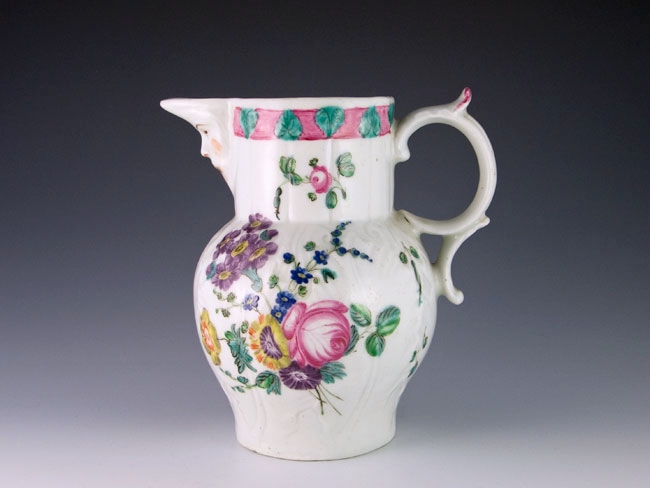A rare Baddeley-Littler porcelain Jug, circa 1777-85
The rounded body of this diminutive Baddeley-Littler porcelain jug is moulded with overlapping cabbage leaves, the mask-head spout delicately painted with a bearded man’s face. Both sides of the rounded body are painted with colourful bouquets of European flowers and sprigs, including a tulip, rose, primula, auricula and forget-me-not. The moulded borders are picked out with distinctive green leaves reserved on a pink band. The handle is of characteristic double-scroll form with thumbrest.
Unmarked.
Condition: Excellent – no damage or restoration, just a clay tear and a firing crack where the handle was applied to the body. The colourful enamels are in superb order. The light kiln spit-out is typical of Baddeley-Littler wares.
Dimensions: Height 14.5 cm (to top of thumbrest)
William Littler was connected with the Longton Hall manufactory in Staffordshire from 1750-60, before going on to produce porcelain at West Pans, near Musselburgh in Scotland. After 1777, it is likely that Littler returned to Staffordshire where he began to produce porcelain with Ralph Baddeley, although the enterprise was relatively short-lived.
Baddeley-Littler porcelains do not fit into the usual porcelain groups of the period as it is not of the hard paste type, nor does it have a soapstone or bone-ash body. It is a glassy soft paste frit porcelain with a high lead content, similar to that of the earlier Longton Hall wares. There is a tendency for the glaze to bubble and discolour.
Staffordshire Porcelain, Geoffrey Godden, Ed. (Granada, 1983).











